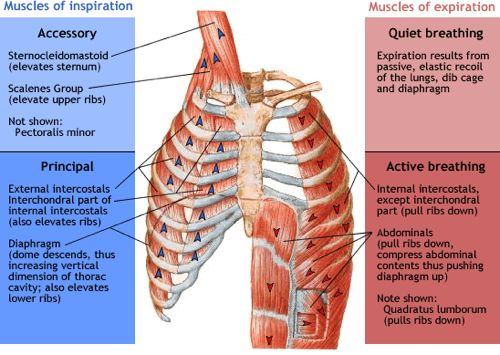Muscles of Respiration
Original Editors - Rachael Lowe
Top Contributors - Khloud Shreif, Andeela Hafeez, Candace Goh, Vidya Acharya, Rachael Lowe, Admin, George Prudden, Kim Jackson, Evan Thomas, Tomer Yona, Lucinda hampton, WikiSysop, Joao Costa, Lenny Vasanthan T, Sai Kripa, 127.0.0.1 and Rishika Babburu -
Introduction[edit | edit source]
The muscles of respiration are also called the 'breathing pump muscles', they form a complex arrangement in the form of semirigid bellows around the lungs. All muscles that are attached to the human rib cage have the inherent potential to cause a breathing action. Muscles that helpful in expanding the thoracic cavity are called the inspiratory muscles because they help in inhalation, while those that compress the thoracic cavity are called expiratory muscles and they induce exhalation. These muscles possess exactly the same basic structure as all other skeletal muscles, and they work in concert to expand or compress the thoracic cavity.[1]
The speciality of these muscles are that they are composed of fatigue resistant muscle fibers, they are controlled by both voluntary and involuntary mechanisms (if we want to take a breath we can, even if we do not think about breathing the body automatically does it)[2]
Primary Muscles[edit | edit source]
The primary inspiratory muscles are the diaphragm and external intercostals. Relaxed normal expiration is a passive process, happens because of the elastic recoil of the lungs and surface tension. However there are a few muscles that help in forceful expiration and include the internal intercostals, intercostalis intimi, subcostals and the abdominal muscles.[3]
The muscles of inspiration elevate the ribs and sternum, and the muscles of expiration depress them.[4].
Accessory Muscles[edit | edit source]
The accessory inspiratory muscles are the sternocleidomastoid, the scalenus anterior, medius, and posterior, the pectoralis major and minor, the inferior fibres of serratus anterior and latissimus dorsi, the serratus posterior anterior may help in inspiration also the iliocostalis cervicis[4]. Technically any muscle attached to the upper limb and the thoracic cage can act as an accessory muscle of inspiration through reverse muscle action (muscle work from distal to proximal)[2]
The accessory expiratory muscles are the abdominal muscles: rectus, abdominis, external oblique, internal oblique and transversus abdominis. And in the thoracolumbar region the lowest fibres of iliocostalis and longissimus, the serratus posterior inferior and quadratus lumborum.
The accessory muscles are recruited during times of exercising because of the increased metabolic need and also during dysfunction in the respiratory system[3]
Diaphragm[edit | edit source]
Origin: Xiphoid process (posterior surface), lower six ribs and their costal cartilage (inner surface) and upper three lumbar vertebrae as right crus and upper two lumbar vertebrae as left crus.
Insertion: central tendon
Nerve Supply: Motor nerve supply by Phrenic nerve (C3 C4 C5) and sensory supply by phrenic nerve to central tendon and lower 6 or 7 intercostal nerve to peripheral parts.[5]
Intercostal muscles[edit | edit source]
They are three types: External intercostal muscles, internal intercostal muscles, and innermost intercostal muscles.
External intercostal muscles:
- Origin: inferior border of rib above and
- Insertion: superior border of rib below
Internal intercostal muscles:
- Origin: from the costal groove (lower part of inner surface of rib near the inferior border) of the rib above and
- Insertion: upper border of rib below
Innermost intercostal muscles:
- It is an incomplete muscle layer and crosses more than one intercostal space. These muscles assist in the function of external and internal intercostal muscles.
- Origin: from the costal groove of the rib above and
- Insertion: the superior border of rib below
Nerve supply: all the intercostal muscles are supplied by their respective intercostal nerves.[5]
References[edit | edit source]
- ↑ Breathe Strong, Perform Better by Alison McConnell http://www.humankinetics.com/excerpts/excerpts/learn-the-anatomy-and-physiology-of-the-muscles-involved-in-breathing
- ↑ 2.0 2.1 Pamela K. Levangie, Cynthia C. Norkin, 2005, Joint structure and function: A comprehensive analysis, 4th. Edn, Philadelphia, FA Davis publishers.
- ↑ 3.0 3.1 Musles of Respiration, Wikipedia pagehttps://en.wikipedia.org/wiki/Muscles_of_respiration (accessed 30 June 2018)
- ↑ 4.0 4.1 http://voiceandalexandertechnique.eu/voice-anatomy/pharynx-and-larynx/muscles-involved-in-voice-production/muscles-of-respiration.html
- ↑ 5.0 5.1 Snell's Clinical Anatomy http://teachinganatomy.blogspot.com/2013/07/respiratorymuscles.html







